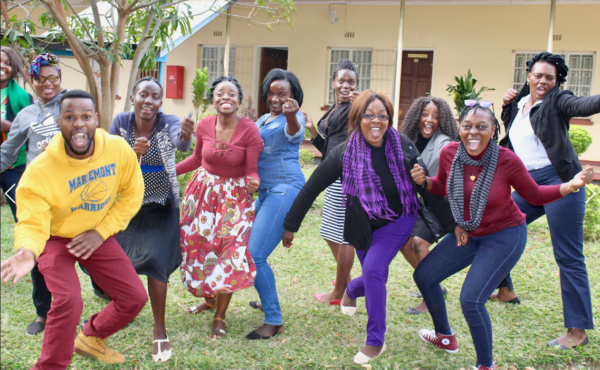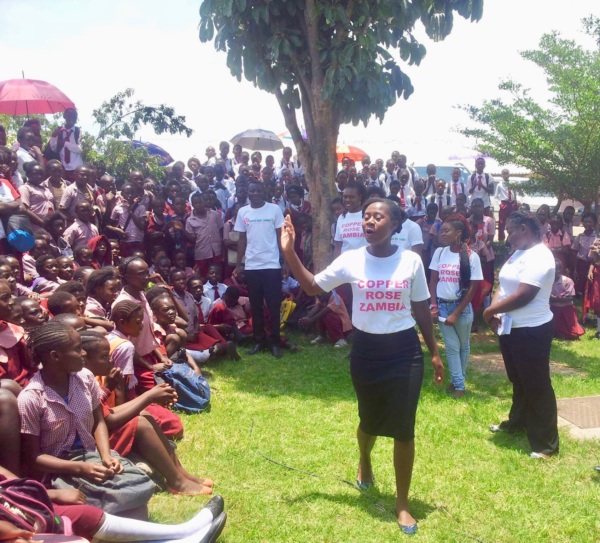Global Financing Facility: Evidence Briefs

What inspired you to get involved in this work?
I first started working on reproductive health in my final high school year, after I noticed someone leave class due to a lack of sanitary napkins. Having attained puberty quite late myself, I started carrying sanitary napkins to school so I could assist other girls when they needed them. As I went on to university, I teamed up with like-minded individuals forming an NGO called Copper Rose Zambia. We started by doing a door-to-door fundraiser on our campus and raised $300 which we used to purchase sanitary napkins for underprivileged girls in a school outside Lusaka. Since then, I have been using my skills and knowledge to educate others about their sexual and reproductive health and rights (SRHR) through various programs in five districts in Zambia. The name “Copper Rose” is a call for women and girls to be appreciated because unlike copper, the country’s chief export, women are a non-diminishing resource.

What has surprised you most about your work and why?
What surprised me is that a lot of young people are willing to use their skills and knowledge to help others, even in low-resource settings. I’ve seen that poverty is not an excuse; we can all create changes in small yet significant ways.
How do you feel you/your organization is making a difference?
My organization has empowered close to 100 young people with the skills to work as volunteers in community action teams. These young people conduct comprehensive sexuality education trainings in their local communities, increasing demand for SRHR services and bringing about change from within through local advocacy. In addition, Copper Rose has reached out to more than 15,000 young women and girls through provision of menstrual hygiene management education and products. This has enabled them to stay in school. What makes our model unique is that we are not only providing menstrual hygiene management products but also skills which may be useful for life, long after our projects have been completed.
What keeps you motivated during difficult times?
What motivates me is knowing that the greatest inheritance I can ever leave on this world is my influence. Seeing the impact of my work on the lives of other people makes me feel like it is worth it. Some of the girls in Copper Rose-sponsored programs will be graduating from high school this year. Knowing that my contribution has made a tangible difference makes me realize that it may be difficult, but it’s an unforgettable experience.
Why is it important to have young people at the table when making adolescent and youth sexual and reproductive health (AYSRH) policy?
Young people need to be at the table for AYSRHR policy because they are in a position to understand their own needs and direct the conversation in matters pertaining to young people. In Africa today, close to 60 percent of the population is made up of youth. They need to be at the table to ensure that attention is drawn to the issues that matter most. Over the last few years, we have increasingly seen more young people seated at the table where policies are being formulated. For example, young people have seats on various boards and occupy other high positions. However, this has not culminated in youth involvement at every stage of programming. Young people are left out in implementation either by direct exclusion or lack of funding, or other forms of support to guarantee their continued participation.

Based on your experience, what happens when young people are not meaningfully engaged in policy discussions?
When young people are not involved, the solutions that are developed to solve their issues end up being ineffective because they may be correct theoretically, but they may not be practical for the acceptance and uptake by the young people themselves. This unacceptability often results in waste of resources which could otherwise be used for other programs and policy implementation.
As we commemorate youth day this year, it will be important for us to think about what meaningful youth engagement means by looking back at the progress we have made in our individual places of work and organizations. Governments and other stakeholders need to incorporate young people from the beginning of the program all the way to the end. To start, government institutions and other stakeholders should have youth staff; this will expose them to the benefits of having youth voices. As they start to engage with youth outside their usual environments, it is important for institutions to create an environment that will allow young people to feel comfortable contributing to discussions and making their voices heard.
What challenges have you experienced related to your work and how have you overcome them?
Some of the biggest challenges facing youth-led organizations is the inadequacy of resources—both human and financial. Youth-led organizations work mostly with volunteers, but young people like adults need to earn a living, so they often drop out of programming. The high turnover of the workforce in youth-led organizations takes a lot of time away from work, because new recruits often require training and capacity building.
Other challenges that I have experienced in my work are related to criticism that comes with working on difficult subjects in the midst of social, cultural and religious taboos—especially in a country like Zambia which has been declared “Christian.” Being an advocate for sensitive subjects such as abortion or rights of key populations often comes with criticism from friends and family. However, one way I have overcome it is to stay consistent and come to accept that it is difficult but essential for the welfare of future generations. With consistency, these subjects become slowly acceptable. One of the examples I can use to show that there is hope is the re-entry policy for teenage mothers who drop out of school. Twenty years ago, if a girl became pregnant while in school she was not allowed back. But 20 years later, the re-entry policy is being implemented, allowing girls to come back to school. While social norms and taboos may remain the same as 20 years ago, persistence and solidarity on policy change is effective when dealing with AYSRH challenges.
We are fighting back against the onslaught of harmful policies that discard reproductive rights.
Stay informed about the issues impacting sexual and reproductive health and rights.
